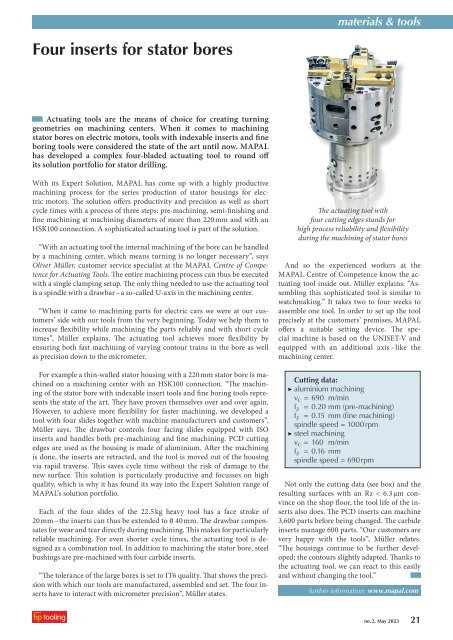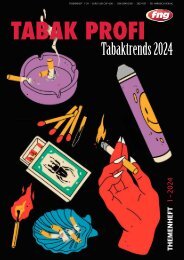hpt 2023 #2
■ Diamond coatings on cutting inserts ■ Grinding requires smart automation ■ News from LIGNA ■ ■ New tool concept based on the Fibonacci principle ■ Filtration solutions for coatings and finish applications ■
■ Diamond coatings on cutting inserts ■ Grinding requires smart automation ■ News from LIGNA ■
■ New tool concept based on the Fibonacci principle ■ Filtration solutions for coatings and finish applications ■
You also want an ePaper? Increase the reach of your titles
YUMPU automatically turns print PDFs into web optimized ePapers that Google loves.
materials & tools<br />
Four inserts for stator bores<br />
Actuating tools are the means of choice for creating turning<br />
geometries on machining centers. When it comes to machining<br />
stator bores on electric motors, tools with indexable inserts and fine<br />
boring tools were considered the state of the art until now. MAPAL<br />
has developed a complex four-bladed actuating tool to round off<br />
its solution portfolio for stator drilling.<br />
With its Expert Solution, MAPAL has come up with a highly productive<br />
machining process for the series production of stator housings for electric<br />
motors. The solution offers productivity and precision as well as short<br />
cycle times with a process of three steps: pre-machining, semi-finishing and<br />
fine machining at machining diameters of more than 220 mm and with an<br />
HSK100 connection. A sophisticated actuating tool is part of the solution.<br />
“With an actuating tool the internal machining of the bore can be handled<br />
by a machining center, which means turning is no longer necessary”, says<br />
Oliver Müller, customer service specialist at the MAPAL Centre of Competence<br />
for Actuating Tools. The entire machining process can thus be executed<br />
with a single clamping setup. The only thing needed to use the actuating tool<br />
is a spindle with a drawbar – a so-called U-axis in the machining center.<br />
“When it came to machining parts for electric cars we were at our customers’<br />
side with our tools from the very beginning. Today we help them to<br />
increase flexibility while machining the parts reliably and with short cycle<br />
times”, Müller explains. The actuating tool achieves more flexibility by<br />
ensuring both fast machining of varying contour trains in the bore as well<br />
as precision down to the micrometer.<br />
For example a thin-walled stator housing with a 220 mm stator bore is machined<br />
on a machining center with an HSK100 connection. “The machining<br />
of the stator bore with indexable insert tools and fine boring tools represents<br />
the state of the art. They have proven themselves over and over again.<br />
However, to achieve more flexibility for faster machining, we developed a<br />
tool with four slides together with machine manufacturers and customers”,<br />
Müller says. The drawbar controls four facing slides equipped with ISO<br />
inserts and handles both pre-machining and fine machining. PCD cutting<br />
edges are used as the housing is made of aluminium. After the machining<br />
is done, the inserts are retracted, and the tool is moved out of the housing<br />
via rapid traverse. This saves cycle time without the risk of damage to the<br />
new surface. This solution is particularly productive and focusses on high<br />
quality, which is why it has found its way into the Expert Solution range of<br />
MAPAL’s solution portfolio.<br />
Each of the four slides of the 22.5 kg heavy tool has a face stroke of<br />
20 mm – the inserts can thus be extended to 0 40 mm. The drawbar compensates<br />
for wear and tear directly during machining. This makes for particularly<br />
reliable machining. For even shorter cycle times, the actuating tool is designed<br />
as a combination tool. In addition to machining the stator bore, steel<br />
bushings are pre-machined with four carbide inserts.<br />
“The tolerance of the large bores is set to IT6 quality. That shows the precision<br />
with which our tools are manufactured, assembled and set. The four inserts<br />
have to interact with micrometer precision”, Müller states.<br />
The actuating tool with<br />
four cutting edges stands for<br />
high process reliability and flexibility<br />
during the machining of stator bores<br />
And so the experienced workers at the<br />
MAPAL Centre of Competence know the actuating<br />
tool inside out. Müller explains: “Assembling<br />
this sophisticated tool is similar to<br />
watchmaking.” It takes two to four weeks to<br />
assemble one tool. In order to set up the tool<br />
precisely at the customers’ premises, MAPAL<br />
offers a suitable setting device. The special<br />
machine is based on the UNISET-V and<br />
equipped with an additional axis – like the<br />
machining center.<br />
Cutting data:<br />
▶ aluminium machining<br />
v c = 690 m/min<br />
f z = 0.20 mm (pre-machining)<br />
f z = 0.15 mm (fine machining)<br />
spindle speed = 1000 rpm<br />
▶ steel machining<br />
v c = 160 m/min<br />
f z = 0.16 mm<br />
spindle speed = 690 rpm<br />
Not only the cutting data (see box) and the<br />
resulting surfaces with an Rz < 6.3 µm convince<br />
on the shop floor, the tool life of the inserts<br />
also does. The PCD inserts can machine<br />
3,600 parts before being changed. The carbide<br />
inserts manage 600 parts. “Our customers are<br />
very happy with the tools”, Müller relates.<br />
“The housings continue to be further developed;<br />
the contours slightly adapted. Thanks to<br />
the actuating tool, we can react to this easily<br />
and without changing the tool.”<br />
further information: www.mapal.com<br />
no. 2, May <strong>2023</strong><br />
21


















